People-Driven Mobility: DEI Perspectives from Industry Leaders Show a Path Forward that Focuses on the Occupant Over Vehicle
Posted: April 13, 2022
Transportation in America over the past century has grown with personal vehicles as the anchor bias, Alisyn Malek says, and this default has led to many putting the car before the trip.
“In many places, if you can’t afford your own vehicle, you’re essentially deprived of the freedom of movement,” Malek said during her keynote address on equitable mobility at SAE International’s 2022 World Congress Experience (WCX).
Malek, Executive Director for the Coalition for Reimagine Mobility and author of Intersection: Reimagining the Future of Mobility Across Traditional Boundaries, has spent much of her career studying the infrastructure issues that have arisen as cars have reshaped landscapes and contributed to issues around urban sprawl and pollution. In her research, Malek has identified areas of improvement that will help the mobility industry better provide for underserved populations.
“Our system cannot default to cars as the first and only opportunity,” Malek said, “A transportation system built for cars is often built at the expense of people.”
Moving forward in a way that prioritizes the occupant, not the vehicle, involves making sure every person has at least two ways to get to where their going, and involves an investment in clean-energy, public transportation that provides for shared mobility.
Moderator Colleen Casey, Toyota North America, and a panel featuring, Valerie Lefler, Feonix Mobility Rising; Ellen Partridge, Shared Use Mobility Center (SUMC); Laura Chace, ITS America, considered what these supports could look like in a discussion following Malek’s address.
The panel emphasized that including diverse perspectives in conversations around designing the future of mobility is crucial, but when polling the audience on how often they include diverse perspectives in their planning, 44% said only sometimes, while 23% said rarely, and 13% said never.
“We have to step out of our own lens and consider everyone who encounters these systems [of transportation] while designing our vehicles,” Chace said. “Really understanding your community and its needs is critically important.”
Questions of access must consider elderly and low-income populations who traditionally have greater difficulty accessing transportation, the panel emphasized. In some communities, they shared, a simple trip to a medical appointment can require prior planning to ensure access to a vehicle with low reliability its availability and transportation times upwards of two hours one way. In other cases, car-sharing solutions have been introduced to these communities, but many residents are non-licensed drivers and having shared vehicles does little to solve their problems.
“We need to look at how we can encourage the right [transportation] tool and when it works,” Partridge said. “A car is a wonderful thing, but it’s not always the right tool for every job.”
As mobility professionals look at engineering the future, the panel agreed engineers must focus on users and create multimodal solutions that take into account the larger transportation ecosystem if mobility is to become truly equitable.
